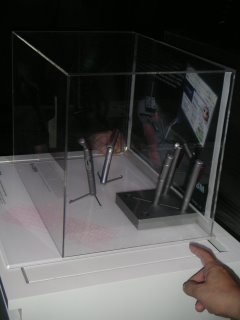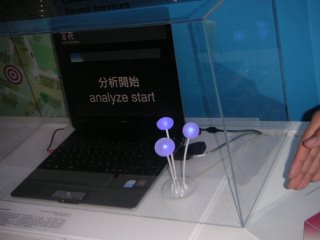 13 October 2006 @ Singapore Expo
13 October 2006 @ Singapore ExpoWelcome!
By tapping our personalised card* against the "swip spot", we are "recognised!"
*RFID (radio frequency identification) tag
What it suggests... if everyone of us is going to have such a all-purpose personalised card...
... in school
- when the pupil comes in the morning and flashes his card against the spot, his attendance is automatically marked and he is greeted with a welcome message by the school (that changes everyday...)
- with such an intelligent card that comes with all the bio-data and medical record, etc... linked between the organisations... the school captures all the necessary information that save the school cockpit team in the school to verify and ensuring all info is correct, an d the PE dept will know who are the pupils with medical condition and needs to be taken care of, etc... oh yes, our teachers no longer need to chase after the pupils for medical certificate if they were absent from class when unwell.
... at work
- when reporting to work, a cheery personalised message makes our day, won't it?

Hello, hello
The speakers dangles from the celling... you can listen to the brief on what's on the wall.
Does it resemble something that we once have fun?... replace the speakers with the cups and put it against your mouth... Remember those good old days?

Once upon a time...
Oops! This reminds me the days when we did our NIE projects to find out trace the development of technology...
Yes, it tells us how intelligent mankind has been...
 the Y2K Bug?!
the Y2K Bug?!Still remember the "Ho-Ha" it made?!
Everybody and almost everything... waiting for the moment to come "0000h", 1 Jan 2000. Lots of quesitons in heads of many... will the day come? or will everything comes to a stand-still?
We have been using technology for so many years... our reliance on technology grows every day, every moment, we did not really question what happens if technology simply evaporates from our world one day? Indeed, I guess not many people at that point of time did not think of how our behaviour is going to change, our habits are going to be affected if what to do if technology is suddenly withdrawn from this world, but everybody's thinking of ways to overcome, to find a way to manage the problem, to minimise disruption... interesting, isn't it? We don't look back, but forward...
... It's still very clear in my mind... the whole team of key personnel, including the admin staff were called back to the school on 1 Jan 2000. We were all at the AV room... while the Principal went through some kind of operational procedures, and each of us were tasked to check on some aspects - that has something to do with the system... That was the year that I spent my New Year day in the school :D

Ball Game without ball
It's an old game played in a new way... clear and neat!
The "balls" are projected and moved according to the movements of the human hands detected by the sensors. Amazing...
* Free up game: that emphasize the themes of collaboration and convergence.
* The game took place on a round table and required 5 players to play by sweeping coloured balls into the right circles with their hands.
* Infra-red cameras above the table mapped out the position of the players' hands, allowing them to act as a cursor of sorts.
 Swip, swip
Swip, swipAh-ha... this is one of the many huge boards that we find everywhere in the exhibition.
Simply read the question/comment and tap our card against the option that we choose.
Indeed, this is one means to capture responses for a survey, too? Brilliant!
 P-ism
P-ismA prototype... that tells us how small computers can be!
No longer need to lug the heavy notebook or tablet with us... just bring the 5 pens! The keyboard will be 'projected' on the base where we can 'touchless'-type (hahaha)... then the 'monitor' will be 'projected' Hm... will that mean some plain backdrop like a white wall is needed for the" shell-less monitor"?

What's your mood today?
More amazing than a crystal ball, huh?
By say a word into the microphone, the software interprets your mood!
Hey, tested with a cheery voice... guess what's the interpretation? "SAD" Oops! I'm confused! ;P

Fuel-cell Mobile Phones
Mobile phones are to be powered by these fuel cells instead of the conventional batteries we use nowadays...
Wah! I can do away with those bulky charges when I go overseas... hooray...
Oops, I'm going to bring "fuel" with me when going out... if I were to travel for many many days... there goes my baggage weight limits! hahaha...
 On the ball at all times!
On the ball at all times!The phone enables one to connect to a hub at the locaton where one situates.
In the example showcased, when we make our learning journey to Victoria Theatre, there, we can connect to the local hub and download information pertaining to Victoria Theatre onto the phone to learn more about the place. To make the journey a meaningful one, the teacher can also also the pupils to attempt a quiz that will give response to the inputs immediately. Amazing! We no longer need to print worksheets for pupils to read or do, of course, no need to mark their worksheets! We can also save our breath to side-line as a guide to give 'commentries' to our pupils...

Something to ponder...
"Leave... think and dream, and occasionally switch off the mobile phone."
Yes. Indeed, it set us thinking... since when we are so used to carrying a mobile phone with us, anytime, anywhere...
Still remember the giant handphone that the 'uncles' held and talked loudly? (as if scare nobody knew that they can afford wireless communication then.)
As the equipment gets cheaper, smaller, sleeker, it becomes a fashion to own one! OK, before that pager was very very popular. Remember the "peep" sound?
So, has mobile phone brought people closer to each other? Why own a mobile phone? or has it actually widen the distance between people?